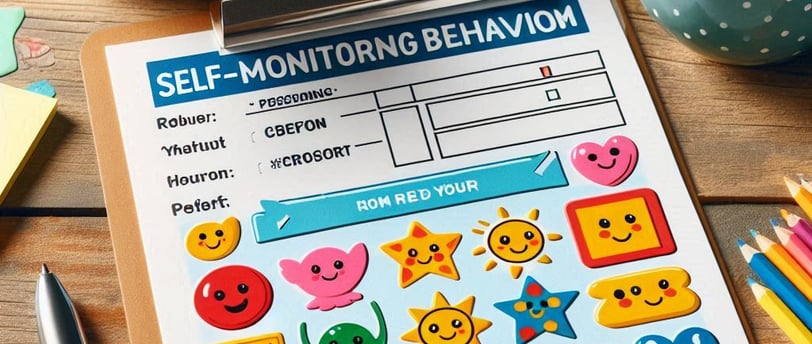Self-Monitoring Behavior Form: A Comprehensive Guide
Self-monitoring behavior is a valuable skill that enhances self-awareness, productivity, and relationships. Whether for personal growth, professional success, or emotional intelligence, using a self-monitoring behavior form helps track behaviors and make meaningful improvements. By integrating self-monitoring into daily life, individuals can develop better habits, stronger relationships, and greater success.
SELF-HELP
kanav pareek
4/2/20256 min read


Self-monitoring behavior is a psychological concept that refers to an individual’s ability to regulate and adjust their actions based on social cues and self-awareness. This skill plays a crucial role in both personal and professional life, influencing decision-making, emotional intelligence, and relationships.
In today's world, self-monitoring is more relevant than ever. From students striving for academic excellence to professionals refining their communication styles, the ability to self-monitor can drive significant success. By using structured tools like a self-monitoring behavior form, individuals can gain better control over their actions, track patterns, and make conscious improvements.
This article explores the intricacies of self-monitoring behavior, backed by academic research and real-world applications. Additionally, we provide a step-by-step guide on creating and utilizing a self-monitoring behavior form to enhance self-awareness and effectiveness.
Understanding Self-Monitoring Behavior
The Psychology Behind Self-Monitoring
Self-monitoring is deeply rooted in psychology. Psychologists Mark Snyder and colleagues have extensively studied this trait, identifying it as a spectrum—some individuals are high self-monitors, while others are low self-monitors.
High self-monitors are highly attuned to social cues and can modify their behavior accordingly. They excel in social adaptability and often thrive in dynamic environments.
Low self-monitors tend to remain consistent in their behavior across situations, valuing authenticity over adaptability.
Both types have their strengths and weaknesses, but the ability to self-monitor effectively can be developed and refined through conscious practice and self-awareness tools.
The Role of Self-Monitoring in Personal Development
Emotional Intelligence and Self-Awareness
Self-monitoring contributes to higher emotional intelligence, which includes skills like:
Recognizing personal emotions
Understanding the emotions of others
Managing responses to social situations
Building stronger relationships
Benefits of Self-Monitoring in Daily Life
Self-monitoring can significantly impact:
✅ Decision-making – Making more thoughtful choices
✅ Time management – Identifying productivity patterns
✅ Health and fitness – Tracking habits for a healthier lifestyle
✅ Communication skills – Adjusting tone and body language
By adopting a self-monitoring mindset, individuals can identify areas of improvement and develop strategies to enhance personal growth.
Self-Monitoring in the Workplace
How Self-Monitoring Affects Professional Interactions
In a professional setting, self-monitoring behavior is key to:
Effective leadership – Managers who self-monitor adapt their communication styles to suit their teams.
Better teamwork – Employees who assess their interactions can create a more collaborative environment.
Conflict resolution – Understanding social cues allows for smoother conflict management.
Enhancing Leadership and Communication Skills
Leaders who engage in self-monitoring:
📌 Recognize the strengths and weaknesses of their team members
📌 Adapt their strategies based on feedback
📌 Foster an environment of open communication
Research and Thesis on Self-Monitoring Behavior
Academic Perspectives on Self-Monitoring
Studies have shown that self-monitoring directly impacts social adaptability and career success. A thesis by Mark Snyder (1974) introduced the Self-Monitoring Scale, which remains a widely used measure in behavioral psychology.
Key findings from research include:
High self-monitors excel in networking and sales careers.
Low self-monitors are more authentic and resistant to peer pressure.
Self-monitoring enhances emotional regulation and resilience.
Creating a Self-Monitoring Behavior Form
A self-monitoring behavior form serves as a structured tool for tracking and evaluating personal behaviors.
Essential Components of an Effective Form
🔹 Behavior to monitor – Clearly define what you want to track (e.g., punctuality, social interactions).
🔹 Situation/Context – Note where and when the behavior occurs.
🔹 Thoughts and Feelings – Reflect on emotions linked to the behavior.
🔹 Desired Changes – Outline actionable improvements.
🔹 Self-Reflection Notes – Keep a record of progress over time.
Step-by-Step Guide to Designing a Useful Template
1️⃣ Identify key behaviors to track.
2️⃣ Choose a format (digital or paper-based).
3️⃣ Set a review schedule (daily, weekly, or monthly).
4️⃣ Regularly analyze trends and make adjustments.


How to Use a Self-Monitoring Behavior Form Effectively
A self-monitoring behavior form is only useful if applied correctly. Here’s how to maximize its benefits:
Best Practices for Tracking Behavior
📍 Be consistent – Regularly record observations to identify trends.
📍 Be honest – The more truthful the input, the more accurate the self-analysis.
📍 Analyze patterns – Look for recurring behaviors to address underlying issues.
📍 Adjust goals – Modify behaviors based on tracked data for continuous improvement.
How to Analyze and Improve Based on Insights
Once you gather sufficient data, reflect on:
🔹 Strengths – What behaviors contribute positively to your life?
🔹 Weaknesses – What habits need improvement?
🔹 Triggers – What causes undesirable behavior?
🔹 Solutions – What strategies can help adjust these behaviors?
Examples of Self-Monitoring Behavior Forms
Pre-Made Templates for Different Scenarios
Different contexts require different tracking methods. Some useful templates include:
1️⃣ Personal Growth Form – Tracks emotional responses and decision-making.
2️⃣ Workplace Productivity Form – Focuses on time management and task efficiency.
3️⃣ Health and Fitness Form – Monitors dietary habits, exercise, and sleep.
4️⃣ Social Interaction Form – Analyzes communication patterns and relationships.
How Businesses and Individuals Can Utilize Them
📌 Companies use them for employee performance reviews and leadership development.
📌 Students use them for improving study habits and time management.
📌 Athletes use them to track physical and mental performance.
Benefits of Using a Self-Monitoring Behavior Form
Self-monitoring forms provide numerous advantages, including:
✅ Increased self-awareness – Recognizing habits and their impact on daily life.
✅ Enhanced goal-setting – Setting realistic and measurable objectives.
✅ Improved productivity – Eliminating time-wasting behaviors.
✅ Better emotional regulation – Identifying stressors and coping mechanisms.
By consistently using a self-monitoring form, individuals can develop habits that lead to long-term success and fulfillment.
Challenges in Self-Monitoring and How to Overcome Them
Despite its benefits, self-monitoring can be challenging. Common obstacles include:
Common Obstacles Faced in Self-Monitoring
🚧 Lack of consistency – Forgetting to record behaviors.
🚧 Self-deception – Not being truthful in tracking.
🚧 Overcomplication – Using too many metrics, leading to frustration.
Practical Strategies for Maintaining Consistency
🔹 Set reminders – Use alarms or apps to prompt entries.
🔹 Keep it simple – Track only essential behaviors.
🔹 Make it a habit – Incorporate tracking into a daily routine.
🔹 Review regularly – Assess progress and adjust as needed.
Digital Tools for Self-Monitoring
Apps and Software That Facilitate Self-Monitoring
Several tools simplify self-monitoring:
📱 Daylio – Tracks moods and habits.
📱 Habitica – Turns self-improvement into a game.
📱 RescueTime – Analyzes productivity and screen time.
📱 MyFitnessPal – Helps monitor health and fitness goals.
The Generosity Factor in Self-Monitoring
Self-monitoring not only improves personal behavior but also fosters generosity and empathy.
How Self-Monitoring Promotes Kindness and Self-Improvement
When people track their behaviors, they become more:
💡 Aware of their impact on others
💡 Mindful of how they treat colleagues, friends, and family
💡 Intentional in practicing kindness and generosity
Real-Life Examples of Self-Monitoring Leading to Generosity
📌 Employees who track workplace interactions report better teamwork and cooperation.
📌 Parents who monitor parenting styles develop stronger relationships with their children.
📌 Leaders who self-monitor communication create a more positive work environment.
By enhancing self-awareness, self-monitoring encourages personal growth that benefits both the individual and those around them.
Case Studies and Real-Life Applications
Examples of Individuals Benefiting from Self-Monitoring
🔹 Sarah, a student, used self-monitoring to track study habits, improving her GPA by 20%.
🔹 Mark, a manager, self-monitored his leadership approach, leading to a 30% increase in team productivity.
🔹 Emily, a fitness enthusiast, tracked nutrition and workouts, resulting in sustainable weight loss.
How Businesses Use Self-Monitoring for Employee Development
💼 Google encourages employees to track productivity and work habits for better performance.
💼 Tesla implements self-monitoring strategies in leadership training programs.
💼 Amazon uses self-monitoring to enhance customer service interactions.
These cases prove that self-monitoring is a powerful tool for self-improvement and professional success.
Future of Self-Monitoring and Behavioral Science
Emerging Trends and Research
🔍 AI-driven self-monitoring tools
🔍 Wearable technology for tracking mental and physical health
🔍 Psychological research on self-monitoring and emotional intelligence
Predictions on Self-Monitoring Advancements
➡️ Integration with AI and machine learning for smarter behavior tracking
➡️ Gamification techniques to make self-monitoring more engaging
➡️ Expanded use in mental health therapy and coaching
Self-monitoring is evolving, and future innovations will make it even more effective and accessible.
Conclusion and Final Thoughts
Self-monitoring behavior is a valuable skill that enhances self-awareness, productivity, and relationships. Whether for personal growth, professional success, or emotional intelligence, using a self-monitoring behavior form helps track behaviors and make meaningful improvements.
By integrating self-monitoring into daily life, individuals can develop better habits, stronger relationships, and greater success.
Final Thought:
💡 "You can't change what you don't measure. Start self-monitoring today and take control of your future."
MORE CONTENT
1 Positive Vibes: Surround Yourself with Positivity
2 What Is Diverse Perspectives? A Comprehensive Analysis
3 What Are Diverse Perspectives? Understanding the Power of Multiple Viewpoints
FAQs
1. What is the main purpose of self-monitoring behavior?
Self-monitoring helps individuals track and adjust their behavior based on social cues and personal goals, leading to improved self-awareness and success.
2. How can I start using a self-monitoring behavior form?
Begin by identifying key behaviors, choosing a tracking method (paper or digital), and consistently recording observations to analyze patterns over time.
3. What are the challenges of self-monitoring?
Common challenges include inconsistency, lack of honesty, and overcomplicating the process. Overcome them by setting reminders, simplifying tracking, and reviewing progress regularly.
4. How does self-monitoring impact professional life?
In the workplace, self-monitoring improves leadership skills, enhances communication, and boosts productivity by fostering self-awareness and adaptability.
5. Are digital self-monitoring tools better than paper-based ones?
Both have pros and cons. Digital tools offer convenience and automation, while paper-based methods encourage deeper reflection and fewer distractions. Choose based on personal preference.
Blog
Content
Engage
contact@growthtimewithme.com
© 2024. All rights reserved.
